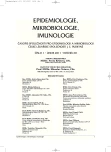Bazovská S., Ďurovská J., Pancák J., Záborská M., Derdáková. M.: Lyme Borreliosis and Demyelinating Disease of the Central Nervous System
Authors:
S. Bazovská 1; J. Ďurovská 2; J. Pancák 2; M. Záborská 3; M. Derdáková. 4
Authors‘ workplace:
Ústav epidemiológie, Lekárska fakulta UK v Bratislave
1; I. neurologická klinika, Univerzitná nemocnica v Bratislave
2; Mikrobiologický ústav, Lekárska fakulta UK v Bratislave
3; Parazitologický ústav SAV v Košiciach
4
Published in:
Epidemiol. Mikrobiol. Imunol. 60, 2011, č. 1, s. 45-47
Overview
A case report is presented of a 55-year-old patient diagnosed with a demyelinating disease of unclear etiology. The patient had Lyme borreliosis in 2004. Specific IgG antibodies against B. burgdorferi s. l. were detected in the serum. Intrathecal antibodies were not found in the cerebrospinal fluid, but the presence of B. garinii DNA was confirmed by PCR analysis. It can be hypothesized that the borrelial persistence in the body may have been one of the triggers of the autoimmune process resulting in demyelination of the central nervous system (CNS).
Keywords:
demyelinating disease of the CNS – B. garinii DNA in the cerebrospinal fluid.
Sources
1. Ascherio, A., Munger, K. L. Environmental risk factors for multiple sclerosis. Part I: the role infection. Ann. Neurol., 2007, 4, p. 288–299.
2. Bazovská, S., Guryčová, D., Výrosteková, V. et al. Protilátky proti pôvodcom niektorých prírodne ohniskových nákaz v sérach darcov krvi zo západného Slovenska. Epidem. Microbiol. Immunol., 2010, 59, 4, s. 168–171.
3. Hartmann, M., Pfadenhauer, K. Intrathecal antibody production against Borrelia burgdorferi in a patient with relapsing-remitting multiple sclerosis. Europ. J. Neurol., 2003, 10, 6, p. 747–748.
4. Honegr, K., Hulínská, D., Dostál, V. et al.: Perzistence Borrelia burgdorferi sensu lato u pacientu s lymeskou boreliózou. Epidem. Microbiol. Immunol., 2001, 50, 1, p. 10–16.
5. Moravcová, L., Pícha, D., Vaňousová, D., Hercogová, J. Průkaz boreliové DNA u pacientů s neuroboreliózou a erythema migrans. Klin. Mikrobiol. infek. Lék., 2009, 5, s. 159–164.
6. Pícha, D., Moravcová, L., Holečková, D. et al. Examination of specific DNA by PCR in patients with different forms of Lyme borreliosis. Int. J. Dermatol., 2008, 47, p. 1004–1010.
7. Sarma Das Jayasri A Mechanism of Virus-Induced Demyelinination. Inderdiscip. Perspect. Infect. Dis., 2010, 21 June, p. 1–35.
8. Smetanová, K., Burri, C., Peréz et al. Detection and identification of Borrelia burgdorferi sensu lato genospecies in ticks from three different region in Slovakia. Wien. Klin. Wochenschr. 2007, 119, p. 17–18, p. 534–537.
9. Schmutzhard, E. Multiple sclerosis and Lyme borreliosis. Wien. Klin. Wochenschr., 2002, 114, p. 13–14, p. 539–543.
10. Staines, D. R. Are multiple sclerosis and amyotrophic lateral sclerosis autoimmune disorders of endogenous vasoactive neuropeptides? Med. Hypothesis, 2008, 70, p. 413–418.
11. Strle, F., Ruzič-Sabljič, J., Cimperman, S. et al. Comparison of Findings for Patients with Borrelia garinii and Borrelia afzelii Isolated from Cerebrospinal Fluid. Clin. Infect. Dis., 2006, 43, p. 704–710.
Labels
Hygiene and epidemiology Medical virology Clinical microbiologyArticle was published in
Epidemiology, Microbiology, Immunology

2011 Issue 1
Most read in this issue
- Antibiotická rezistence Streptococcus pneumoniae a Streptococcus pyogenes v letech 1996–2009
- Bazovská S., Ďurovská J., Pancák J., Záborská M., Derdáková. M.: Lyme Borreliosis and Demyelinating Disease of the Central Nervous System
- Hrabák J., Žemličková H., Bergerová T., Urbášková P.: Interpretation of the Susceptibility Test Results in Enterobacteria Producing 3rd- and 4th-Generation Cephalosporin- or Carbapenem-Hydrolyzing β-Lactamases
- Kissová R., Maďarová L., Klement C.: Laboratory Diagnosis of Pandemic Influenza at the Department of Medical Microbiology of the Regional Authority of Public Health Based in Banská Bystrica in the Season 2009–2010
